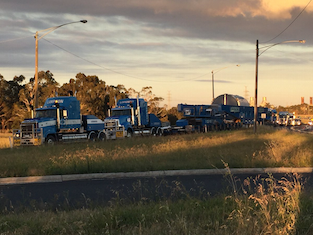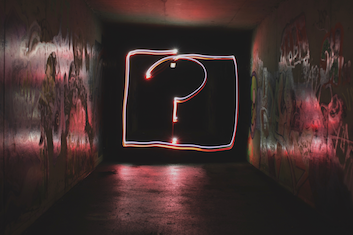Do: the neglected third auxiliary verb
 In special situations, including where we want to give our verb extra strength or emphasis, we use a third auxiliary verb to power our sentences: the verb to do
In special situations, including where we want to give our verb extra strength or emphasis, we use a third auxiliary verb to power our sentences: the verb to do
Verbs are often defined as doing, being and having words, as I discussed in an earlier post. While the special role of the verbs to be and to have as auxiliaries to convey tense and aspect is widely covered, the doing words are usually not explained, or explained just as being all other action words. But the verb to do is a special auxiliary, with three functions:
- to create a question
- to provide added emphasis to a sentence
- to negate a verb, forming a negative sentence.
Creating a question

There are several ways that we create questions in English, as we will see in a future post on the interrogative mood. One way is place the verb at the start of the sentence. For example, if we want to change the sentence I was at work yesterday into a question, we simply move the verb (I) to the start of the sentence: Was I at work yesterday? When we have an auxiliary and participle, we split the verb around a noun (the person or thing performing the noun) to create a question.
- The generator was transported by two truck engines.
- Was the generator transported by two truck engines?
- I have used a picture of a question mark.
- Have I used a picture of a question mark?
- You will marry me.
- Will you marry me?
When we have a simple (one word) verb, for all verbs except the verb to be, we use do as an auxiliary, in the same position as the auxiliaries in the previous examples. Without a do auxiliary, the question can sound poetic and Shakespearean – or just strange.
- I sat at my desk yesterday.
- Did I sit at my desk yesterday? Not Sat I at my desk yesterday?
Note that the tense is shown by the form of do used; the main verb does not take a participle form but uses its root or infinitive form. If we want to convey continuous, perfect or perfect continuous aspect, or future tense, we use the be and have auxiliaries.
- Two truck engines provided the power to carry the generator.
- Did two truck engines provide the power to carry the generator? Not Provided two truck engines the power to carry the generator?
- I used a picture of a question mark.
- Did I use a picture of a question mark? Not Used I a picture of a question mark?
- You want to marry me.
- Do you want to marry me? Not Want you to marry me?
Remember: we use do for questions only with the simple (one word) form of verb that does not have a be or have auxiliary.
Providing emphasis
![]()
 We also use do when we want to give extra emphasis to the verb in a sentence. Do provides extra oomph, or extra power, like using an extra truck engine to tow a very heavy load. Again, as when we use do to create questions, when we use do for emphasis, we use it with the bare infinitive form of the main verb. And again, we don’t use do is not where the other auxiliaries are used.
We also use do when we want to give extra emphasis to the verb in a sentence. Do provides extra oomph, or extra power, like using an extra truck engine to tow a very heavy load. Again, as when we use do to create questions, when we use do for emphasis, we use it with the bare infinitive form of the main verb. And again, we don’t use do is not where the other auxiliaries are used.
- You finished the job becomes You did finish the job.
- He came yesterday becomes He did come yesterday.
- I like chocolate becomes I do like chocolate.
- My sister cooks very well becomes My sister does cook very well.
The commonly used replies of the bride and groom in a marriage service are short versions of sentences that use do for emphasis.
- I do (take this woman to be my wife).
- I do (take this man to be my husband).
Forming negatives

 The final way we use do as an auxiliary is to form a negative sentence, together with the word not (or its contraction, n’t). Again, we use do when we have the simple (one-word) form of a verb; when we have a be or have auxiliary, that auxiliary combines with not to form a negative sentence.
The final way we use do as an auxiliary is to form a negative sentence, together with the word not (or its contraction, n’t). Again, we use do when we have the simple (one-word) form of a verb; when we have a be or have auxiliary, that auxiliary combines with not to form a negative sentence.
- I finished the post.
- I did not (or didn’t) finish the post.
- I have finished the post.
- I have not (or haven’t) finished the post.
- I am finishing the post.
- I am not finishing the post.
- I want to leave.
- I don’t want to leave.
- Take my photograph!
- Don’t take my photograph!
As with questions, if we used not with the simple form of the verb, the sentence would sound strange:
- I finished not the post.
- I want not to leave.
I don’t know why do is so neglected, when its uses are so specific and straightforward. You should be able to remember them easily. The immortal words of Yoda in The Empire Strikes Back remind us of the auxiliary uses of do (for negatives) and that do is quite different from a catenative verb (try is a catenative verb):


If you have found this post interesting, you can find a full index to my other posts on the index page. To be notified when I post a new topic, follow me on Facebook! If you have any particular questions you’d like me to answer in future posts, just send me a message. I’m always interested to learn what people think, and how you came across this site, so please post a comment.
If you think you would be interested in either my complete grammar course or an individual customised online course (particularly suited for people who don’t live in Melbourne), just click your preferred option.

4 comments on “Verbs: do – the emphatic, questioning and negative auxiliary”